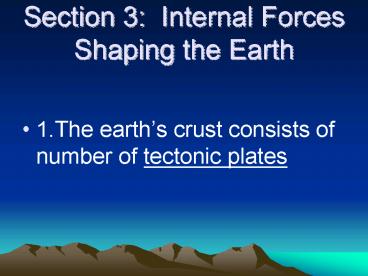Section 3: Internal Forces Shaping the Earth - PowerPoint PPT Presentation
1 / 21
Title:
Section 3: Internal Forces Shaping the Earth
Description:
Types of boundary movements: Divergent plates move apart, spreading horizontally. Convergent Plates collide, causing either one plate to dive under the other or ... – PowerPoint PPT presentation
Number of Views:138
Avg rating:3.0/5.0
Title: Section 3: Internal Forces Shaping the Earth
1
Section 3 Internal Forces Shaping the Earth
- 1.The earths crust consists of number of
tectonic plates
2
- 2. tectonic plates - enormous moving pieces of
the earths lithosphere - (p. 37)
3
Types of boundary movements
- Divergent plates move apart, spreading
horizontally - Convergent Plates collide, causing either one
plate to dive under the other or the edges of
both plates to crumple - Transform plates slide past each other
4
- 3. Movement
- of the plates
- produces
- earthquakes
- and volcanoes
- Fault fracture in the earths crust where
plates move past each other
5
- Earthquake - Violent movement of the earth as the
plates grind or slip past each other at a fault - Seismograph a device that measures the size of
the waves created by and earthquake
6
Epicenter
- Point directly above the focus of an earthquake
on the earths surface - Richter Scale uses information collected by
seismographs to determine the strength of an
earthquake
7
Tsunami
- A giant wave in the ocean caused by an
underground earthquake
8
Volcanoes crack in the earths surface where
magma and gases pour out
Lava magma that has reached the earths surface
9
The Ring of Fire
- The most active volcano and earthquake zone on
earth
10
(No Transcript)
11
External Forces Shaping the Earth
- Weathering and erosion alter the surface of the
earth - Weathering physical and chemical processes
that change the characteristics of rock on or
near the earths surface
12
- Sediment - Small pieces of rock created by
weathering (mud, sand or silt) - Mechanical Weathering processes that break rock
into smaller pieces (doesnt change the
composition of rock, but the size) - example road construction
13
- Chemical Weathering occurs when rock is changed
into a new substance as a result of interaction
between elements in the air or water and minerals - (example iron rusting)
14
Erosion
- Occurs when weathered material is moved by the
action of wind, water, ice and gravity
15
- 2. Water, wind, and glaciers cause erosion
16
wind erosion
Loess windblown silt and clay sediment that
produces very fertile soil
17
Water Erosion
- Delta sediment is deposited in a fan-like
landform when a river enters an ocean
18
Glacial Erosion
- Glacier a large, long-lasting mass of ice that
moves because of gravity - Glaciation changing of landforms by slowly
moving glaciers - Moraine rocks left behind from a glacier that
form a ridge or hill
19
Glacier
20
Moraine
21
- 3. Weathering and erosion help form soil
- Soil Factors
- Parent Material
- Relief
- Organisms
- Climate
- Time































